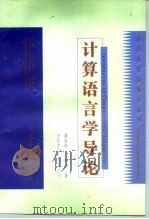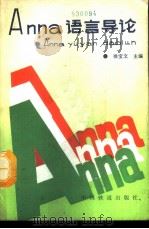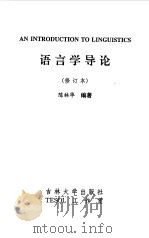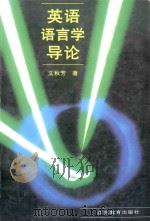《语言学导论》
| 作者 | 陈林华编著 编者 |
|---|---|
| 出版 | 未查询到或未知 |
| 参考页数 | |
| 出版时间 | 1989(求助前请核对) 目录预览 |
| ISBN号 | 无 — 求助条款 |
| PDF编号 | 820079698(仅供预览,未存储实际文件) |
| 求助格式 | 扫描PDF(若分多册发行,每次仅能受理1册) |

Introduction1
1.Linguistics Is the Science of Language1
2.The Scope of Linguistics3
3.Approaches to the Study of Language4
4.Grammar5
5.Schools of Linguistics7
Chapter One:Language11
1.What Is Language?12
1.1.Language is a special social phenomenon12
1.2.Language is a well-organized system of linguistic symbols12
1.3.The language system is unique to human beings15
2.Social Functions of Language17
2.1.Language,as a communicative means,serves society17
2.2.Language is the most important communicative means18
2.3.Language is the means for conceptual thinking20
3.Language and the Human Brain22
3.1.The structure of the human brain22
3.2.Functions of the brain23
4.The Conceptual Thinking of the Deaf-mute25
5.The Origin of Language26
6.Animal Communication Systems28
Exe rcise 133
Chapter Two:Phonetics:The Sounds of Language34
1.The Phonetic Alphabet35
2.English Consonants and Vowels40
3.The Study of Phonetics45
4.Articulatory Phonetics46
4.1.The articulatory organs47
4.2.Articulation of English consonants49
(1)Place of articulation51
(2)Manner of articulation53
4.3.Description of English vowels65
5.Natural Classes of Speech Sounds69
Exercise 270
Chapter Three:Phonology:The Sound Pattern of Language75
1.Phonemes:The Phonological Units of Language76
1.1.Distinctive features of phonemes78
1.2.Nondistinctive features83
2.Suprasegmental Phonemes88
3.Sequences of Phonemes94
3.1.Constraints on sequences of phonemes95
3.2.Syllables96
4.Phonological Rules99
5.The Formalization of Phonological Rules108
Exercise 3113
Chapter Four:Morphology:The Structure of Words119
1.Morphemes:The Smallest Meaningful Units of Language121
1.1.What is a morpheme?121
1.2.Morphemes,morphs,allomorphs123
1.3.Analysis of morphemes124
1.4.Derivational and inflectional morphemes126
2.Morphological Rules of Word Formation129
3.Other Ways to Form Words133
3.1.Conversion133
3.2.Abbreviation(or Shortening)134
3.3.Back-formation134
3.4.Blending135
3.5.Onomatopoeia(or Imitation)135
3.6.Reduplication(or Repetition)136
3.7.Sentence-condensation136
3.8.Acronymization137
4.The Phonetic Representation of Morphemes137
Exercise 4141
Chapter Five:Syntax:The Structure of Sentences145
1.Grammatical Rules145
1.1.Paradigmatic rules146
(1)Parts of speech147
(2)Inflection150
(3)Grammatical categories151
1.2.Syntagmatic rules163
(1)Combination of morphemes into words163
(2)The basic patterns of combinations of words164
(3)Constituent structure167
2.Grammatical Units173
3.The Sentence Patterns of Language176
3.1.The syntactic rules176
3.2.Phrase-structure rules183
3.3.Fitting in morphemes and words189
3.4.Recursive rules192
3.5.Deep and surface structures195
3.6.Transformational rules198
3.7.The phonological and semantic components209
3.8.Ambiguity in surface structure and grammatical relationship revealed in deep structure210
Exercise 5216
Chapter Six:Semantics:The Meaning of Language219
1.Meaning,Concept,Referent220
2.Sense and Reference221
3.The Meaning of Morphemes and Words222
4.Semantic Features and Componential Analysis227
5.Monosemy and Polysemy228
6.Homonymy230
7.Sense Relations between Words233
7.1.Synonymy233
7.2.Antonymy237
8.Idioms241
9.Combination of Meanings of Words245
10.The Meaning of Sentences245
11.The Study of Pragmatics250
11.1.Context250
11.2.Speech acts252
Exercise 6253
Chapter Seven:Language Acquisition257
1.Stages in Child Language Acquistion258
1.1.The babbling stage259
1.2.The holophrastic stage260
1.3.The two-word stage261
1.4.The telegraphic stage262
1.5.The full language acquistion stage264
2.Different Views on Child Language Acquistion265
2.1.Postnatal learning265
2.2.Innate linguistic competence269
Exercise 7271
Chapter Eight:Language Variation273
1.Dialects273
1.1.Geographical dialects274
1.2.Social dialects275
1.3.Styles279
1.4.Slang,jargon and taboo281
1.5.Standard and nonstandard dialects284
2.Lingua Francas285
3.Pidgin and Creole Languages289
4.Esperanto:An Artificial Language298
Exercise 8301
Chapter Nine:Historical-Comparative Linguistics303
1.Grimm's Law and Verner's Law:Sound Correspondence304
2.Languages of the World307
3.The Genetic Classification of Languages309
4.Language Families314
4.1.The Indo-European Family316
4.2.The Sino-Tibetan Family317
4.3.The Afro-Asiatic Family319
4.4.The Caucasian Family319
4.5.The Uralic Family320
4.6.The Altaic Family320
4.7.The Dravidian Family321
4.8.The Malayo-Polynesian Family321
4.9.The Niger-Kordofanian Family321
5.Typological Classification of Languages323
5.1.Isolating languages324
5.2.Agglutinating languages325
5.3.Inflectional languages327
5.4.Polysynthetic languages331
6.Structural Classification of Languages332
Exercise9334
Chapter Ten:Language Change338
1.A Brief History of English338
2.Phonetic Changes341
3.Phonological Changes343
3.1.Changes in phonemes and phonological rules344
3.2.The Great Vowel Shift348
4.Morphological Changes350
5.Syntactic Changes353
6.Lexical Changes356
6.1.Word Coinage357
6.2.Borrowing358
7.Semantic Changes365
7.1.Broadening and Narrowing365
7.2.Elevation and Degradation367
8.Causes of Language change368
Exercise 10372
Chapter Eleven:Writing System374
1.The Origin and Development of Writing376
1.1.The origin of writing376
1.2.The development of writing378
2.Modern Types of Writing Systems383
3.Reformation of Writing System385
4.Writing and Speech390
Exercise 11397
Reference Books399
Glossory401
1989《语言学导论》由于是年代较久的资料都绝版了,几乎不可能购买到实物。如果大家为了学习确实需要,可向博主求助其电子版PDF文件。对合法合规的求助,我会当即受理并将下载地址发送给你。
高度相关资料
-

- 计算语言学导论
- 1998 北京:中国社会科学出版社
-

- 语言学导论
- 1989
-

- 英语语言学导论
- 1991年09月第1版 河南人民出版社
-

- 语言论言语研究导论
- 1985年02月第2版 商务印书馆
-

- 大学语言导读
- 武汉:武汉大学出版社
-

- Anna语言导论
- 1990 北京:中国铁道出版社
-

- 阿尔泰语言学导论 形态学
- 1981 北京:中国社会科学出版社
-

- 语言学导论
- 1999 长春:吉林大学出版社
-

- 汉奸丑史
- 1999 上海:复旦大学出版社
-

- 语言导论
- 1994 北京:北京语言学院出版社
-

- 现代语言学导论
- 1986 福州:福建人民出版社
-

- 应用语言学导论
- 1983 上海:上海外语教育出版社
-

- 文化语言学导论
- 1996 北京:语文出版社
提示:百度云已更名为百度网盘(百度盘),天翼云盘、微盘下载地址……暂未提供。➥ PDF文字可复制化或转WORD

